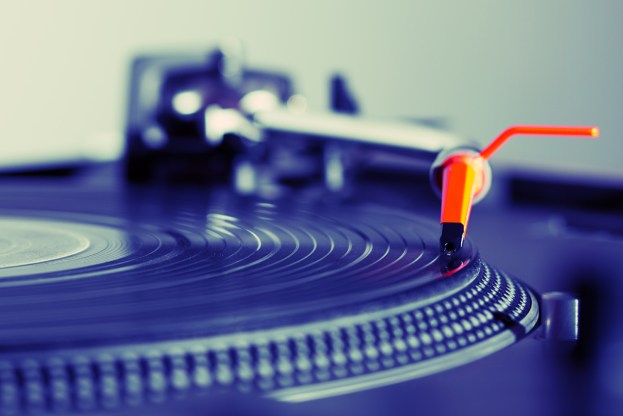
Believe it or not, vinyl is staging a comeback.
According to 2012 sales figures, vinyl record album sales in the United States jumped 17.7 percent to almost 4.55 million units. At the same time, CD sales continued to decline, dropping 13.5 percent from 2011 to 193.4 million units. Digital downloads continued to grow at a very healthy rate and now represent 37.2 percent of all music album sales. And download stores finally passed large discounters such as Target and Walmart with sales of more than 111.7 million units.
The bad news for the music industry is that overall sales declined 4.4 percent. But amidst all that data, the resurgence of vinyl looks impressive; especially because 2012 represented the fifth consecutive year of double-digit sales growth for a format left to die under the metal feet of the Digital Empire’s AT-AT. But does that mean that the renewed interest in vinyl and turntables is a rejection of MP3s by 20-somethings, or is this just another annoying hipster-fueled fad?

Having dug into the numbers and spoken with turntable manufacturers, we think it’s probably a little bit of both. The 17.7 percent jump in vinyl record sales does not include used record sales, and it’s unclear if the math also accounts for all online and indie label offerings. Vinyl still only accounts for 1.44 percent of new U.S. album sales overall, and the top selling album, Jack White’s “Blunderbuss,” moved a paltry 34,000 units. The second best selling LP? The Beatles “Abbey Road”.
In the U.K, the trend is even more encouraging for vinyl, as 2012 sales rose 15.3 percent from 2011 – this, at a time when CD sales declined 20 percent, downloads rose 15 percent, and overall music sales declined 11.2 percent. Only 389,000 new units were sold in Great Britain: The xx, David Bowie, Jack White, Adele, and Tame Impala accounting for the top 5.
On the hardware end, the number of companies manufacturing turntables, tonearms, cartridges, phono stages, and accessories has never been higher. But is this “growth” only being fueled by audiophiles who refuse to let the format die and are willing to spend thousands to dig out every last bit of music from the grooves of their favorite records? Or is it possible that a new generation of listeners weaned on MP3s, who, having already spent hundreds on a pair of headphones and even more on a smartphone, are suddenly curious to discover if music can sound better?
From the perspective of Mat Weisfeld, VP of New Jersey-based VPI Industries, it’s certainly a good time to be an established turntable manufacturer with a solid online and retail presence.

“VPI was started by my parents more than 35 years ago with our first three products being a record weight, table isolation base, and the HW-16 record cleaning machine,” said Weisfeld.
“Our business evolved into the manufacture of our own turntables, and we’ve never looked back with close to 100 dealers in the U.S. and exports to more than 65 countries. The U.K. has become a major focus for us with a new distributor, and we’re thrilled at the reception to our new Traveler turntable which retails for $1,300.”
“…when was the last time anyone ever walked into your living room, pointed to your iPhone and begged you to play it?”
“Vinyl has always been cool,” said Weisfeld. “Turntables have always been industrial art…when was the last time anyone ever walked into your living room, pointed to your iPhone and begged you to play it?”
When asked if he thought the emergence of so many new products was a good thing, Weisfeld was cautiously optimistic, but offered that the market is still quite small and that only established brands with strong retail and online support were in a position to meet demand. Online retailers such as MusicDirect, AcousticSounds and SoundStageDirect have become key to the long-term success of companies like VPI, Pro-Ject, and Rega. And Weisfeld concedes that a lot of new business is being generated that way.
“VPI built its business via the traditional high-end shop, and we’re always going to support our dealers who deal with the established audiophile client, but young listeners are intimidated by the atmosphere and prices, and are just more likely to buy something via the web. The used record stores that survived and are now also selling headphones and affordable tables and cartridges are going to benefit for sure.”

VPI is not the only brand doing well now due to the resurgence of vinyl. Weisfeld points to the success of Rega, Pro-Ject, and Clearaudio as evidence of that.
“There are a lot of really smart people creating some of the best turntables ever made right now, and when you include all of the great cartridge manufacturers such as Grado, Dynavector, Sumiko, Benz Micro, Lyra, and Ortofon, it’s probably the best opportunity you’ll ever have to enjoy vinyl and enhance your love of music,” said Weisfeld.
“The funny thing about our business is that while we sell a lot of turntables – the biggest selling item is still the record cleaning machine. People may find
The venerable turntable may never regain its position as the number one method for music playback but it’s clear that a new generation of music listeners is starting to realize that while one should never trust anyone over 30, their parents may not have been deaf after all. Just slightly.
Top image courtesy of Shutterstock/hurricane


